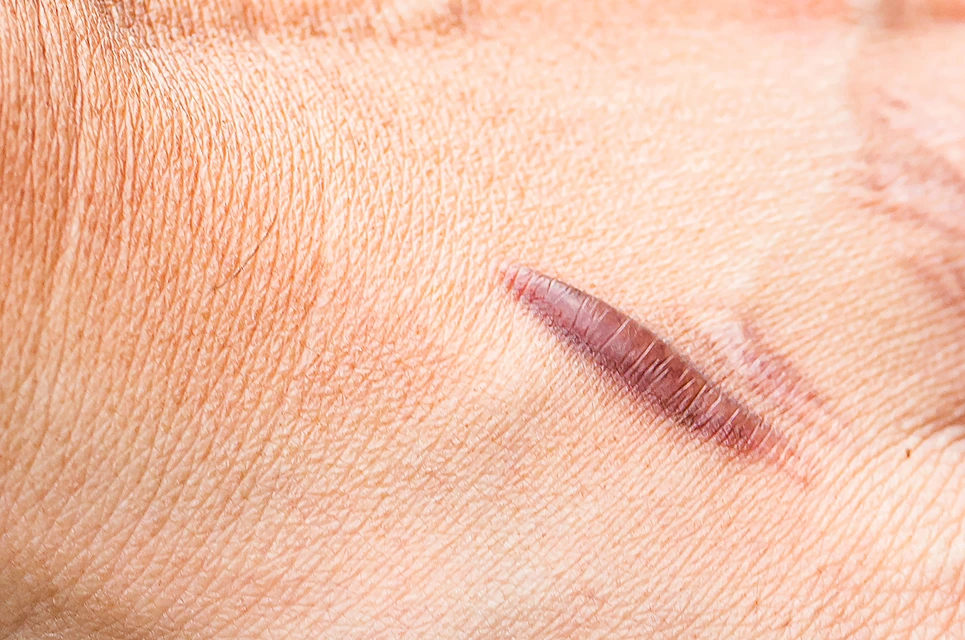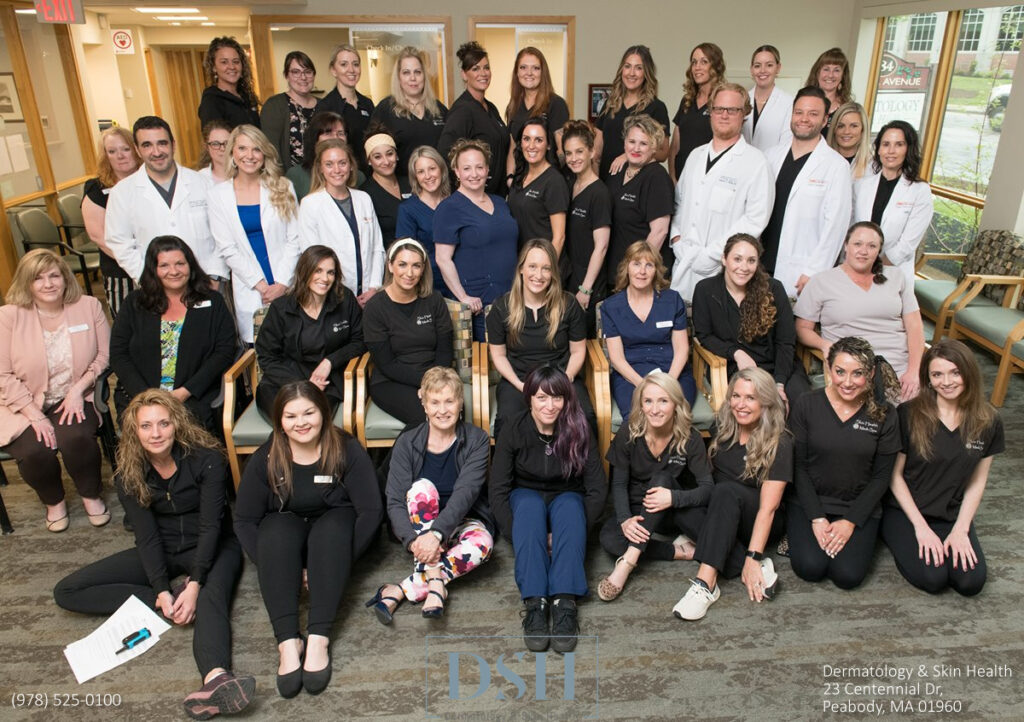

Imagine gazing at your reflection in the mirror, only to find an unfamiliar face staring back. You're not the same person who walked into the surgeon's office, eager to fight off skin cancer through Mohs surgery. While you won your battle against the disease, you were left with an unexpected opponent: lumpy, noticeable scars.
As uninvited guests, these scars may be evoking a myriad of emotions — from frustration to fear, despair to discomfort. But what if we told you there's a comprehensive guide to understanding and managing post-operative scarring after Mohs surgery?
Whether you're still coming to grips with the aftermath of your surgery or searching for ways to feel like yourself again, read on. Together, let's turn these unexpected souvenirs of your battle into badges of survival and resilience.
Mohs surgery, renowned for its precision and efficacy, is a go-to technique when confronting skin cancer, particularly basal cell carcinoma (BCC) and squamous cell carcinoma (SCC). Conducted by a trained and board-certified Mohs surgeon, this advanced procedure involves an incredibly meticulous process.
During the surgery, thin layers of skin are systematically removed and promptly scrutinized under a microscope. This layer-by-layer approach continues until only cancer-free tissue remains, ensuring the highest potential cure rate while simultaneously preserving as much healthy tissue as possible, thereby minimizing scarring.
Beyond its precision, Mohs surgery stands as a gold standard for treating many types of skin cancer due to its ability to minimize the chances of the cancer reappearing. While it effectively removes cancerous cells, the primary goal is to save as much healthy skin as possible.
In certain instances, the nature of the surgical procedure may necessitate the use of skin grafts. In these cses, aa piece of skin from an adjacent, healthy area is strategically used to cover the surgical wound, aiding in the healing process and further minimizing the cosmetic impact of the procedure.
Following the removal of skin cancer through Mohs surgery, the body's natural healing process can result in the formation of several different types of scars. It's essential to recognize these potential outcomes and understand that the appearance of a bump after surgery may be more common than you think.
These are characterized by an overgrowth of collagen at the site of the wound, leading to raised, thickened, and often whitened scars. They develop at the skin level and may stand out. Hypertrophic scars occur due to an overactive healing response, while keloid scars, notably, can extend beyond the boundaries of the original surgical wound and may continue to thicken over time.
These scars are common post-surgery. They typically heal to leave a raised line that progressively fades and flattens over time. While they are not usually painful, they might be itchy for several months.
Also known as pitted or sunken scars, these are characterized by depressed areas on the skin that occur due to loss of tissue during the healing process.
These scars cause tightening in the surrounding tissue, potentially affecting functionality and movement. They pull down the adjacent skin and can significantly change the appearance of the affected area.
Post-operative spots can be a result of sun exposure, aging, or the surgery itself. They are typically harmless but might be cosmetically undesirable for some patients.
Among skin cancer treatment options, Mohs surgery boasts a high cure rate reaching up to 99%, minimizing the possibility of skin cancer recurrence. Yet, patients should remain vigilant for signs of future skin cancers, especially if they have a skin type prone to sun damage.
The symptoms of skin cancer can vary depending on the type of skin cancer. Here are some common symptoms associated with different types of skin cancer:
| Common Symptoms | Basal Cell Carcinoma | Squamous Cell Carcinoma | Melanoma |
| A pearly or waxy bump | ✔ | ||
| A flat, flesh-colored, or brown scar-like lesion | ✔ | ||
| A bleeding or scabbing sore that heals and returns | ✔ | ||
| A large brownish spot with darker speckles | ✔ | ||
| A mole that changes in color, size, or feel, or that bleeds | ✔ | ||
| A small lesion | ✔ | ||
| Asymmetrical shape of a mole or spot | ✔ | ||
| Irregular or jagged border of a mole or spot | ✔ | ||
| Uneven color of a mole or spot | ✔ | ||
| Diameter of a mole or spot larger than the size of a pea | ✔ | ||
| Changes in the mole or spot over time | ✔ |
In addition to these specific symptoms, there are more general indications of skin cancer that may not be tied to a particular type. These can include:
Always consult with a healthcare professional if you notice any of these symptoms or any other unusual changes to your skin.

Proper wound care is vital in the days, weeks, and months after surgery. Initially, some bit of blood oozing is normal, and an ice pack can help reduce swelling. The wound should be kept clean using a dry cloth to dab any excess blood gently. The use of an anti-bacterial ointment and butterfly bandages can aid in healing.
Other wound care tips that you can do:
In the weeks after surgery, it's crucial to mind your activities and pay attention to your body's responses to promote optimal healing. Here's what to bear in mind:
There are many scar treatment options available for healing. Over-the-counter silicone sheet brands or silicone gels can be used to apply firm pressure to the scar, aiding in the appearance of scars. In addition, steroid injections, often used in conjunction with silicone strips, can be beneficial in reducing scar size and itching.
Silicone products are a classic option for scar care due to their efficacy in reducing the prominence of hypertrophic scars. They work by creating a moist environment conducive to scar healing, reducing collagen production, and helping the scar blend with normal skin.
| Area | Silicone Gel | Silicone Sheets |
| Composition | Easy-to-apply gel | Soft, flexible, self-adhesive dressings made of 100% silicone |
| Application | Can be used on any skin type, including sensitive skin and in children. Versatile, can be applied on irregular scar surfaces, moving parts, and scars of any size | Applied directly over scars. Can be worn alone or underneath pressure garments, splints, or casts |
| Function | Works by reducing transepidermal water loss and raising the skin surface temperature, which may stimulate collagenase activity. Balances the expression of growth factors to aid in scar healing | Create a protective barrier over the scar, preventing the production of excess scar tissue and aiding scar maturation. They assist with scar hydration, helping the body maintain moisture during the healing process and regulate collagen production, minimizing scarring. Improve the color, height, and texture of a scar, and relieve itching and discomfort |

Facing Mohs surgery is a daunting task, let alone navigating the aftermath that often involves dealing with unexpected lumpy scars. However, understanding these outcomes and exploring your options in managing post-operative scarring can provide hope in restoring your confidence and reclaiming your identity.
Whether you're currently grappling with the impact of Mohs surgery or considering your next steps toward recovery, this guide serves as a comprehensive resource to help you make informed decisions. Remember, your scars are not just reminders of a tough battle, but they also symbolize your bravery and resilience in the face of adversity.
Battling with lumpy scars after Mohs surgery? Our dedicated team at Dermatology & Skin Health is committed to supporting you on this journey. We specialize in delivering top-tier medical and cosmetic treatments including Mohs reconstructive surgery, designed to reduce the appearance of your scars and enhance your skin's health.
We understand how challenging living with facial scarring can be, and that's why we're committed to devising personalized care plans that fit your specific needs. Reach out to us to schedule an appointment today, and let us help you restore confidence in your skin!
If your desired appointment type or preferred provider is unavailable online, kindly call (978) 525-0100 for Peabody, MA and (603) 742-5556 for all New Hampshire locations. Alternatively please feel free to send us your request via the patient portal, or via email at info@dermskinhealth.com
*For medical dermatology appointments in MA please dial (978) 525-0100 or fill out the appointment request form above.